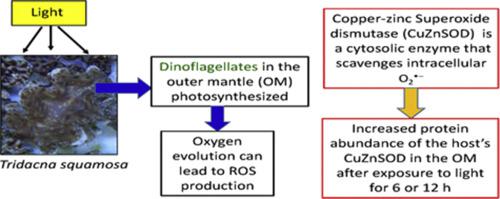Comparative Biochemistry and Physiology A: Molecular & Integrative Physiology ( IF 2.1 ) Pub Date : 2020-08-13 , DOI: 10.1016/j.cbpa.2020.110791 Shit F Chew 1 , Clarissa Z Y Koh 2 , Kum C Hiong 2 , Mel V Boo 2 , Wai P Wong 2 , Yuen K Ip 2

|
The colorful outer mantle of giant clams contains abundance of symbiotic dinoflagellates (zooxanthellae) and iridocytes, and has direct exposure to light. In light, photosynthesizing dinoflagellates produce O2, and the host cells in the outer mantle would be confronted with hyperoxia-related oxidative stress. In comparison, the whitish inner mantle contains few symbiotic dinoflagellates and no iridocytes. It is involved in shell formation, and is shaded from light. CuZnSOD is a cytosolic enzyme that scavenges intracellular O2-. We had obtained from the outer mantle of the fluted giant clam, Tridacna squamosa, the complete cDNA coding sequence of a host-derived copper zinc superoxide dismutase (CuZnSOD), which comprised 462 bp and encoded for 154 amino acids with a calculated MW of 15.6 kDa. CuZnSOD was expressed strongly in the outer mantle, ctenidium, hepatopancreas and kidney. The transcript level of CuZnSOD remained unchanged in the outer mantle during light exposure, but the protein abundance of CuZnSOD increased ~3-fold after exposure to light for 6 or 12 h. By contrast, 12 h of light exposure had no significant effects on the gene and protein expression levels of CuZnSOD/CuZnSOD in the inner mantle. Hence, the increased expression of CuZnSOD in the outer mantle of T. squamosa was probably a host's response to ameliorate oxidative stress related to photosynthesis in the symbionts, and not simply due to increased metabolic rate in the host cells. Evidently, the host clam must possess light- or O2-responsive anti-oxidative defenses in order to align with the light-dependent photosynthetic activity of its symbionts.
中文翻译:

有沟纹的大蛤(Tridacna squamosa)在光照过程中会增加宿主的铜-锌超氧化物歧化酶在多彩外层中的蛋白质丰度,而不是发白内层中的蛋白质丰度。
巨大的蛤outer的外衣五颜六色,含有丰富的共生鞭毛藻和虹膜细胞,并直接暴露于光下。在光下,光合藻鞭毛藻产生O 2,外幔中的宿主细胞将面临高氧相关的氧化应激。相比之下,发白的内层几乎没有共生的鞭毛藻,没有虹膜细胞。它参与壳的形成,并被阴影遮挡。CuZnSOD的是胞质酶清除了细胞内Ö 2 - 。我们从有沟大蛤c Tridacna squamosa的外层中获得了宿主来源的铜锌超氧化物歧化酶(CuZnSOD)的完整cDNA编码序列。),包含462 bp,编码154个氨基酸,计算得出的MW为15.6 kDa。CuZnSOD在外套膜,小脑膜,肝胰腺和肾脏中强烈表达。在暴露过程中,外膜中CuZnSOD的转录水平保持不变,但是暴露于光照6或12 h后,CuZnSOD的蛋白质丰度增加了约3倍。相比之下,光照12 h对内地幔中CuZnSOD / CuZnSOD的基因和蛋白质表达水平没有显着影响。因此,鳞状鳞茎外地幔中CuZnSOD的表达增加这可能是宿主对共生体中与光合作用相关的氧化应激缓解的反应,而不仅仅是由于宿主细胞新陈代谢速率的提高。显然,寄主蛤必须具有对光或O 2响应的抗氧化防御作用,以便与其共生体的光依赖性光合作用保持一致。











































 京公网安备 11010802027423号
京公网安备 11010802027423号